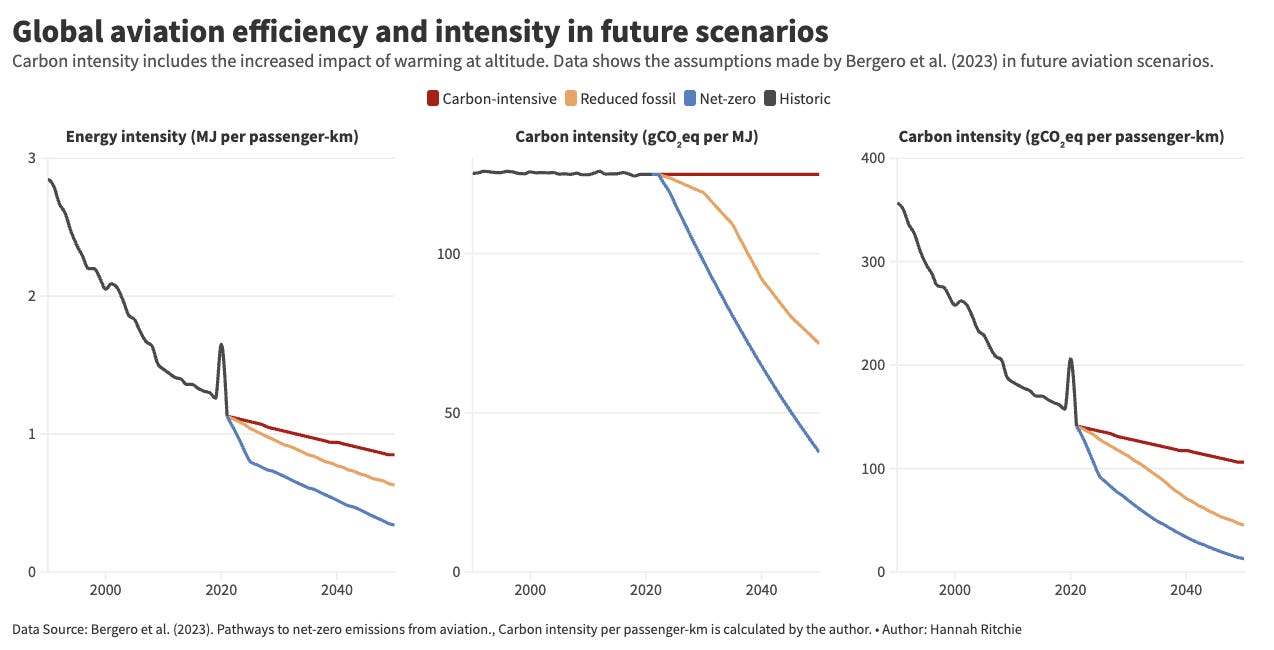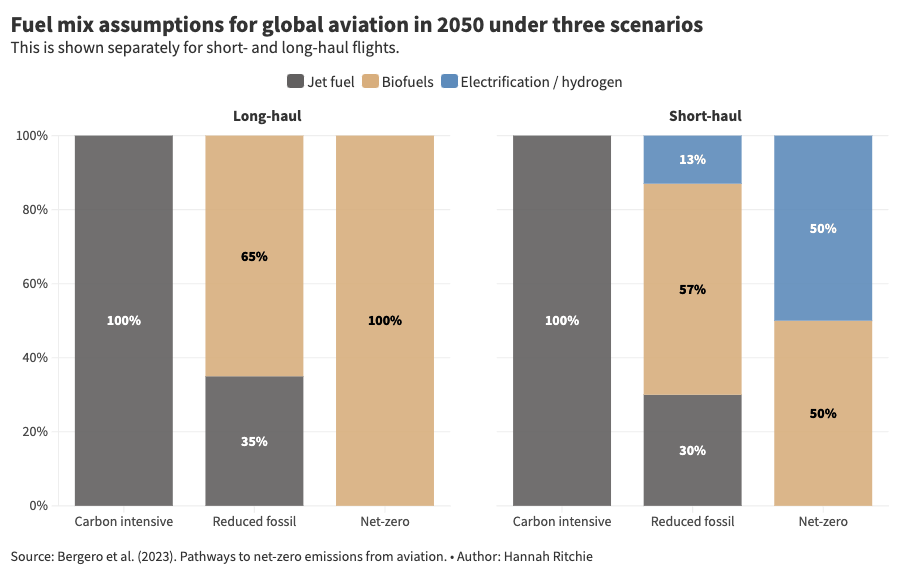How much biofuel would we need to decarbonise aviation?
The world could need four to five times as much land for biofuels as it uses today.
This article is the second in a two-parter on global aviation. In Part One I looked at the history of aviation trends: demand, energy efficiency, and carbon emissions. I also introduced scenarios of how this could change in the future. Here I’ll look at how much biofuel the world would need.In Part One I introduced a range of future scenarios for aviation. These come from a study by Bergero et al. (2023), published in Nature Sustainability.1
Let’s briefly reintroduce them again. The researchers modelled three technology scenarios.
Carbon-intensive: planes continue to use 100% jet fuel, as they do today. Improvements in energy efficiency continue, but the CO2 emitted per unit of energy does not change.
Reduced fossil use: 65% of medium and long-haul flights are powered by ‘sustainable’ aviation fuels (biofuels) and 13% of short-haul flights are powered by electric planes or hydrogen by 2050.
Net zero: biofuels power 100% of medium- and long-haul aviation by 2050. Electric and hydrogen power 50% of short-haul flights, with the rest powered by biofuels.
Here’s what these changes in energy and carbon intensity look like.
They then modelled three scenarios of demand growth: ‘Business-as-usual’ where demand increases at 4% per year; ‘Industry projections’ with a growth of 2.9% per year; and ‘Ambitious demand reduction’ where demand in 2050 is similar to levels in 2019.
Assumptions about biofuels, hydrogen and electrification in each scenario
This is what the assumed fuel mix is in 2050 for each technology scenario.
The carbon-intensive scenario needs no feasibility check on the technology. It uses fossil jet fuel, just as we do today.
The reduced fossil and net-zero scenarios rely on significant quantities of electrification (or hydrogen) for short-haul flights. And they need large amounts of biofuels for medium- and long-haul flights.
Today, the aviation industry only uses tiny quantities of biofuels so we should take a look at how feasible this would be. How much would we need, and what would be the implications for land use?
Could biofuels meet our current global aviation demand?
How does current global biofuel production compare to aviation fuel use?
In 2019, global aviation used around 13 exajoules (EJ) of jet fuel. Global liquid biofuel production – bioethanol and biodiesel – was around 4.3 EJ.2 Almost none of this went to aviation; most of it went toward road transport.
If all the world’s biofuels were used for aviation instead, they could have met one-third of global demand.
What about the United States specifically? When I wrote an article looking at the inefficiency of US biofuels for road transport, some people asked whether it could power its aviation industry instead. The US produces around 1.3 EJ of biofuels per year – most as bioethanol from corn. The EIA reports that US airlines (covering domestic US flights, and some international flights) use 3.6 EJ of fuel.3
That means US biofuels could cover around 37% of US aviation. Or, around 10% of global aviation demand.4
How much biofuel would be needed for aviation in the future?
What about demand in 2050, under the various scenarios proposed above?
If aviation demand continues to increase steeply – in the ‘business-as-usual’ scenario – then biofuel demand could reach up to 20 EJ. This is shown in the chart below. If this growth is a bit slower, this would be around 10 EJ. And in a reduced demand scenario, this would be around 3 EJ.
Note that these scenarios assume that improvements in energy efficiency continue, which might be an optimistic assumption. In that case, demand would be even higher.
Global biofuel production is currently 4.3 EJ.5 That means that in a very ambitious demand reduction scenario, technically, the world could already cover the demand for biofuels in 2050. We would have to stop using biofuels in cars and trucks, and shift them to aviation instead, but given the rise of electric cars, this seems reasonable.
In scenarios of high demand, though, global biofuel production would have to grow four-to-five times. We’d need to produce 16 to 20 EJ.
The problem with this very high biofuel demand is the impact on land use. Large amounts of land would have to be allocated to growing crops. And it could increase competition for using crops for food.
How much land would be needed to produce biofuels for future aviation?
We’ll assume that biofuels come from bioethanol and biodiesel at the same ratios – and from same crops – that are used today.
If yields stayed the same, the amount of land needed to produce biofuels in each scenario is in the table below. This is measured in millions of hectares. In the high-demand scenario where jet fuel is eliminated, we’d need around 300 million hectares of cropland. That’s an area the size of India.
In 2019, the world used around 1600 million hectares of cropland. In the table below I’ve given biofuel land requirements in 2050 as a share of this. In the highest scenarios, it’d equal around one-fifth of current cropland use. In the lowest scenarios, it’s a few percent.
That’s a lot of land, especially in a future where cropland availability will already be squeezed as a result of population and economic growth (which leads to more land-intensive diets).
This cropland demand – which could lead to deforestation at worst, and reduce carbon sequestration in non-forested land at best – comes at a climate cost. The study above assumed that biofuels were ‘carbon-neutral’, but the reality is that they’re often not. They have life-cycle emissions from inputs such as fertilizers, and have carbon costs in terms of land use.
Before the world launched into a ‘net-zero’ aviation strategy based on large amounts of biofuels, I’d want much more detailed emissions footprinting for these fuels to assess what the actual emissions reductions would be.
Cost is the major barrier to biofuel uptake
For airlines, the biggest barrier to biofuel uptake is cost. Converting crops to fuel is energy-intensive, and that hikes up the price compared to petrol or diesel.
Bergero et al. (2023) estimate ‘sustainable fuels’ are around twice the cost of jet fuel, but with a significant range. This price differential could come down if there was a high carbon price (so the jet fuel would get more expensive). But a high carbon price would increase the cost of carbon offsets, which the aviation industry would still need a lot of.
What’s clear is that decarbonising aviation will be an expensive challenge – at least with the current technologies we have. And not just economically: using 300 million hectares of land to produce biofuels comes at a high environmental cost. We need more efficient ways of producing biofuels, or alternative ‘sustainable fuels’.
That’s why early innovation and investments in this area are so important. The cost of decarbonising electricity with solar and wind was once prohibitively expensive too. The cost of batteries made decarbonising road transport impossible, until very recently.
If low-carbon flying is to be economically feasible in a few decades, the world needs to start working on it now.
Bergero, C., Gosnell, G., Gielen, D., Kang, S., Bazilian, M., & Davis, S. J. (2023). Pathways to net-zero emissions from aviation. Nature Sustainability, 6(4), 404-414.
I calculated this using biofuel production figures from the IEA. These are given in litres, so I converted them to MJ (then EJ) using the following conversion factors:
Ethanol: 21.4 MJ per litre
Biodiesel: 32.3 MJ per litre
HVO: 34.4 MJ per litre
https://www.iea.org/data-and-statistics/charts/global-biofuel-production-in-2019-and-forecast-to-2025
US transportation demand from all sectors uses around 30 EJ.
https://www.frontiersin.org/articles/10.3389/fenrg.2021.765360/full
Jet fuel uses around 12% of this, which amounts to 3.6 EJ.
https://www.eia.gov/energyexplained/use-of-energy/transportation.php
Global demand is 13 EJ. If US biofuels are 1.3 EJ, then this could meet 10% of global aviation demand.
That's the amount of energy in biofuels for transport.
Total biofuel production is around 64 EJ. Most of this is traditional biomass – the use of wood and other wastes for cooking and heating (which is the dominant energy source at very low incomes).
Wood burned for buildings and electricity is also a significant bioenergy producer.
https://www.iea.org/articles/what-does-net-zero-emissions-by-2050-mean-for-bioenergy-and-land-use








A major factor you don’t mention is the energy density of the fuels you are discussing. Aviation jet fuel or kerosene has an energy density of 43MJ/l which is much higher than ethanol’s 28MJ/l. This means if a turbofan jet engine could run on ethanol (because of lack of lubricants, turbo jet engines cannot use more than 40% ethanol or the engines will seize) it would need 65% more fuel by weight, either reducing range or increasing prices (to make room for extra fuel storage). This means your simple comparisons are not very accurate. Also battery powered passenger flight is now only possible for very short distances with few passengers, again a consequence of the mass of the batteries needed.
Hannah, there is no reason to assume that the biofuels required to "recarbonize" the global aviation industry must be obtained from farmland. That assumption skews your entire study into ignoring the prime global potential for sustainable liquid fuels.
In reality, prior to the era of subsidized fossil gas (aka "natural gas") the Standard Industry Practice for the production of the versatile liquid fuel methanol [CH3OH] was via feedstock from Native Coppice Forestry for charcoal production, whose hydrocarbon offgasses were reacted to produce methanol. As a leading hydrogen carrier methanol is not only a prime candidate for the feedstock of so-called Sustainable Aviation Fuel (aka synthetic kerosene) it will also serve to some extent as an easily tanked aviation fuel for the Reformer Methanol Fuel Cells that are now in commercial production in Europe, USA, & China.
Since Native Coppice Forestry has traditionally thrived on poor hill lands, its present expansion would logically pose no threat to farmlands. You may recall the 2012 joint study by WRI & WFN of the available land area suitable for afforestation - without taking farmland, native forest or special ecosystems - which identified 1.6Gha.s globally. This is about 152% of the entire global area of arable farmland.
In terms of the methanol yield available from biomass feedstock, the US NREL gave some useful findings (see: https://www.nrel.gov/docs/legosti/old/5570r2.pdf ).
"Estimates of the [USA] biomass resource available for U.S. fuels production average 2.45 billion metric tons per year. One ton of feedstock can be converted to 721 liters (186 gallons) of methanol. As a renewable resource, biomass represents a potentially inexhaustible feedstock supply for methanol production."
With methanol weighing 0.791 kg /litre, the NREL finding indicates a potential output - just from extant US biomass resources - of :- 0.721 m3 x 0.791 t x 2.45Gt feedstock = 1.397Gt /yr methanol output. As the fuel has an LHV of 19.9 GJ /t, the finding points to an energy value of 27.805 EJ in that output. Given that US biomass resources are a small fraction of what 1.6 Gha.s of Native Coppice Forestry could produce, let alone accounting global sustainable biomass resources overall, there is plainly no justification for presenting biofuels as necessarily posing a threat to agriculture.